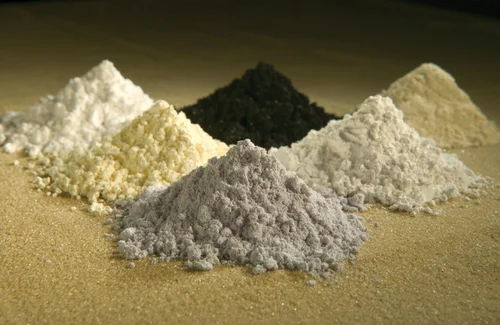 YuYi
YuYi
 Oct 10,2023
Oct 10,2023

Rare earth compound nanopowder is both a new material and a raw material for new materials. At present, the methods for preparing rare earth nanopowders in laboratories and industries include a sol-gel method, precipitation method, hydrolysis method, combustion method, thermal decomposition method, etc. Xu Guogang et al. used triethanolamine and ammonia as gelling agents and used the sol-gel method to prepare a precursor composed of Y2(OH)5.14(NO3)0.86H2O. The precursor was kept at 500℃ for 2h and calcined at 1000℃ for 2h. Y2O3 nanopowder with high crystallinity, good dispersion, average particle size of 50nm, and nearly spherical shape. Liu Zhiqiang et al. added a PEG activator to the CeCl3 solution and used ammonium bicarbonate as the precipitating agent to prepare 50nm cerium oxide by precipitation method.
With the development of science and technology, the performance requirements of products are becoming more and more demanding, requiring products to be ultra-fine, ultra-thin, ultra-high density, and ultra-filled. Thin film preparation methods are divided into two categories: fire method and wet method. Fire methods include magnetron sputtering, spray pyrolysis, inert gas condensation, hydrogen or inert atmosphere CVD, etc., using plasma, laser, electron beam, arc, etc. for heating; wet methods include sol-gel method, hydrothermal method, supercritical hydrothermal synthesis method, precipitation method, etc. The former has a large equipment investment and high cost, but the prepared film has high chemical and mechanical stability; the latter has a low equipment investment, low cost, and is easy to operate.
Currently, there are three major categories of rare earth nanofilms being developed: rare earth complex nanofilms, rare earth oxide nanofilms, and rare earth nanoalloy films. At present, rare earth oxide nano-films such as CeO2, Y2O3, La2O3, Nd2O3, Eu2O3, Gd2O3, Dy2O3, Er2O3, Ho2O3, Tm2O3, CeO2-ZrO2, Y2O3-ZrO2 composites and NdFeB permanent magnet materials have been prepared. Rare earth nanofilms also play an important role in the information industry, catalysis, energy, transportation, and life medicine.

Rare earth catalytic materials are involved in almost all catalytic reactions. Due to the surface effect, volume effect, and quantum size effect of nanometers, rare earth nanotechnology has attracted increasing attention. In many chemical reactions, rare earth catalysts are used. If rare earth nanocatalysts are used, the catalytic activity and catalytic efficiency will be greatly improved.
Rare earth nanocatalysts are generally used in petroleum catalytic cracking and automobile exhaust purification treatment. The most commonly used rare earth nanocatalytic materials are CeO2 and La2O3, which can be used as catalysts, additives, and catalyst carriers.
Nanoceramic powder can significantly reduce the sintering temperature, which can be 200℃~300℃ lower than that of non-nanopowder with the same composition. Adding nano CeO2 to ceramics can reduce the sintering temperature, inhibit lattice growth, and improve the density of ceramics. Adding rare earth elements such as Y2O3, CeO2, or La2O3 to ZrO2 can prevent high-temperature phase transformation and embrittlement of ZrO2, and obtain ZrO2 phase transformation toughened ceramic structural materials.
Antibacterial ceramics can be prepared by adding rare earth-activated photocatalytic composite materials to the glaze formula. Electronic ceramics (electronic sensors, PTC materials, microwave materials, capacitors, thermistors, etc.) prepared using ultra-fine or nanoscale CeO2, Y2O3, Nd2O3, Sm2O3, etc., have improved electrical properties, thermal properties, and stability.
Rare earth permanent magnet materials have gone through three development stages: SmCo5, Sm2Co7, and Nd2Fe14B. At present, the magnetic energy product of sintered Nd2Fe14B rare earth permanent magnet materials has reached as high as 432kJ//m3 (54MGOe) and has entered large-scale production. As a bonded permanent magnet material, fast-quenching NdFeB magnetic powder has a grain size of 20nm to 50nm and is a typical nanocrystalline rare earth permanent magnet material.
Rare earth nanomagnetic materials have the characteristics of small size, single magnetic domain structure, and high coercive force. Used in the production of magnetic recording materials, it can increase the signal-to-noise ratio and improve image quality. Due to its small size and high reliability, it is used in micromotor systems and is an important direction for the development of new-generation aviation, aerospace, and marine motors. Used in magnetic memory, magnetic fluid, and giant magnetoresistance materials, the performance can be greatly improved, making the device high-performance and miniaturized.
The particle size of nano-rare earth-luminescent materials is usually smaller than the wavelength of the excitation or emitted light wave, so the light field can be approximately uniform within the particle range, and there is no microcavity effect caused by the confinement of light waves. For ultra-fine particles, As the size becomes smaller, its specific surface area also increases significantly, resulting in a large surface state density.
In order to solve the problems of energy, environment, resources, etc., the development of hydrogen storage materials has become a hot topic in current materials research. The cost of carbon nanotubes and fibers is high, and the hydrogen storage temperature of high-specific surface activated carbon is too low, so its application range is limited. It is difficult to store and dehydrogenate hydrogen in organic liquids; using rare earth nano-alloy materials to store hydrogen has lower costs and can be produced on a large scale.
Lubricating grease is composed of base lubricating oil and additives. The additives determine the performance of the lubricating oil. Using LaF3-DDP nanopowder synthesized from pyridinium dialkyl dithiophosphate (pyDDP), nano-NaF, and La(NO3)3 as additives, the load-bearing capacity and anti-wear ability of the lubricating oil are significantly improved.

Aerospace, atomic energy, and other fields require metal materials that can withstand high temperatures, have good toughness, and are lightweight. Some additives are often added to alloys to increase strength, but generally, additives tend to coarsen at high temperatures, and their properties deteriorate after long-term use at high temperatures. By uniformly dispersing Y2O3 nanopowder that is stable at high temperatures into the alloy, a strengthened super heat-resistant alloy can be obtained, which can be used in flamethrower nozzles.
